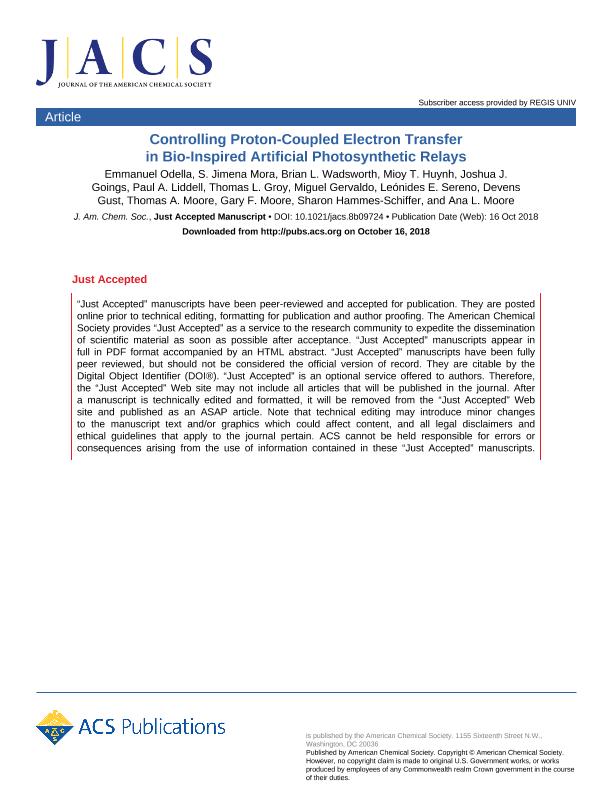Mostrar el registro sencillo del ítem
dc.contributor.author
Odella, Emmanuel

dc.contributor.author
Mora, Sabrina Jimena

dc.contributor.author
Wadsworth, Brian L.
dc.contributor.author
Huynh, Mioy T.
dc.contributor.author
Goings, Joshua J.
dc.contributor.author
Liddell, Paul A.
dc.contributor.author
Groy, Thomas L.
dc.contributor.author
Gervaldo, Miguel Andres

dc.contributor.author
Sereno, Leonides Edmundo

dc.contributor.author
Gust, Devens
dc.contributor.author
Moore, Thomas A.
dc.contributor.author
Moore, Gary F.
dc.contributor.author
Hammes-Schiffer, Sharon
dc.contributor.author
Moore, Ana L.
dc.date.available
2020-05-06T16:51:30Z
dc.date.issued
2018-10
dc.identifier.citation
Odella, Emmanuel; Mora, Sabrina Jimena; Wadsworth, Brian L.; Huynh, Mioy T.; Goings, Joshua J.; et al.; Controlling proton-coupled electron transfer in bioinspired artificial photosynthetic relays; American Chemical Society; Journal of the American Chemical Society; 140; 45; 10-2018; 15450-15460
dc.identifier.issn
0002-7863
dc.identifier.uri
http://hdl.handle.net/11336/104344
dc.description.abstract
Bioinspired constructs consisting of benzimidazole-phenol moieties bearing N-phenylimines as proton-accepting substituents have been designed to mimic the H-bond network associated with the TyrZ-His190 redox relay in photosystem II. These compounds provide a platform to theoretically and experimentally explore and expand proton-coupled electron transfer (PCET) processes. The models feature H-bonds between the phenol and the nitrogen at the 3-position of the benzimidazole and between the 1H -benzimidazole proton and the imine nitrogen. Protonation of the benzimidazole and the imine can be unambiguously detected by infrared spectroelectrochemistry (IRSEC) upon oxidation of the phenol. DFT calculations and IRSEC results demonstrate that with sufficiently strong electron-donating groups at the para-position of the N-phenylimine group (e.g., -OCH3 substitution), proton transfer to the imine is exergonic upon phenol oxidation, leading to a one-electron, two-proton (E2PT) product with the imidazole acting as a proton relay. When transfer of the second proton is not sufficiently exergonic (e.g., -CN substitution), a one-electron, one-proton transfer (EPT) product is dominant. Thus, the extent of proton translocation along the H-bond network, either ~1.6 Å or ~6.4 Å, can be controlled through imine substitution. Moreover, the H-bond strength between the benzimidazole NH and the imine nitrogen, which is a function of their relative pKa values, and the redox potential of the phenoxyl radical/phenol couple are linearly correlated with the Hammett constants of the substituents. In all cases, a high potential (~1 V vs SCE) is observed for the phenoxyl radical/phenol couple. Designing and tuning redox-coupled proton wires is important for understanding bioenergetics and developing novel artificial photosynthetic systems.
dc.format
application/pdf
dc.language.iso
eng
dc.publisher
American Chemical Society

dc.rights
info:eu-repo/semantics/openAccess
dc.rights.uri
https://creativecommons.org/licenses/by-nc-sa/2.5/ar/
dc.subject
Benzimidazole-phenol
dc.subject
Proton-coupled electron transfer
dc.subject
H-bond network
dc.subject.classification
Otras Ciencias Químicas

dc.subject.classification
Ciencias Químicas

dc.subject.classification
CIENCIAS NATURALES Y EXACTAS

dc.title
Controlling proton-coupled electron transfer in bioinspired artificial photosynthetic relays
dc.type
info:eu-repo/semantics/article
dc.type
info:ar-repo/semantics/artículo
dc.type
info:eu-repo/semantics/publishedVersion
dc.date.updated
2020-03-13T18:08:22Z
dc.identifier.eissn
1520-5126
dc.journal.volume
140
dc.journal.number
45
dc.journal.pagination
15450-15460
dc.journal.pais
Estados Unidos

dc.journal.ciudad
Washington
dc.description.fil
Fil: Odella, Emmanuel. Consejo Nacional de Investigaciones Científicas y Técnicas; Argentina. Arizona State University; Estados Unidos. Universidad Nacional de Río Cuarto. Facultad de Ciencias Exactas Fisicoquímicas y Naturales. Departamento de Química; Argentina
dc.description.fil
Fil: Mora, Sabrina Jimena. Universidad Nacional de Córdoba. Facultad de Ciencias Químicas. Departamento de Química Orgánica; Argentina. Consejo Nacional de Investigaciones Científicas y Técnicas; Argentina. Arizona State University; Estados Unidos
dc.description.fil
Fil: Wadsworth, Brian L.. Arizona State University; Estados Unidos
dc.description.fil
Fil: Huynh, Mioy T.. University of Yale; Estados Unidos
dc.description.fil
Fil: Goings, Joshua J.. University of Yale; Estados Unidos
dc.description.fil
Fil: Liddell, Paul A.. Arizona State University; Estados Unidos
dc.description.fil
Fil: Groy, Thomas L.. Arizona State University; Estados Unidos
dc.description.fil
Fil: Gervaldo, Miguel Andres. Universidad Nacional de Río Cuarto. Facultad de Ciencias Exactas Fisicoquímicas y Naturales. Instituto de Investigaciones en Tecnologías Energéticas y Materiales Avanzados. - Consejo Nacional de Investigaciones Científicas y Técnicas. Centro Científico Tecnológico Conicet - Córdoba. Instituto de Investigaciones en Tecnologías Energéticas y Materiales Avanzados; Argentina
dc.description.fil
Fil: Sereno, Leonides Edmundo. Universidad Nacional de Río Cuarto. Facultad de Ciencias Exactas Fisicoquímicas y Naturales. Departamento de Química; Argentina
dc.description.fil
Fil: Gust, Devens. Arizona State University; Estados Unidos
dc.description.fil
Fil: Moore, Thomas A.. Arizona State University; Estados Unidos
dc.description.fil
Fil: Moore, Gary F.. Arizona State University; Estados Unidos
dc.description.fil
Fil: Hammes-Schiffer, Sharon. University of Yale; Estados Unidos
dc.description.fil
Fil: Moore, Ana L.. Arizona State University; Estados Unidos
dc.journal.title
Journal of the American Chemical Society

dc.relation.alternativeid
info:eu-repo/semantics/altIdentifier/url/http://pubs.acs.org/doi/10.1021/jacs.8b09724
dc.relation.alternativeid
info:eu-repo/semantics/altIdentifier/doi/http://dx.doi.org/10.1021/jacs.8b09724
Archivos asociados
